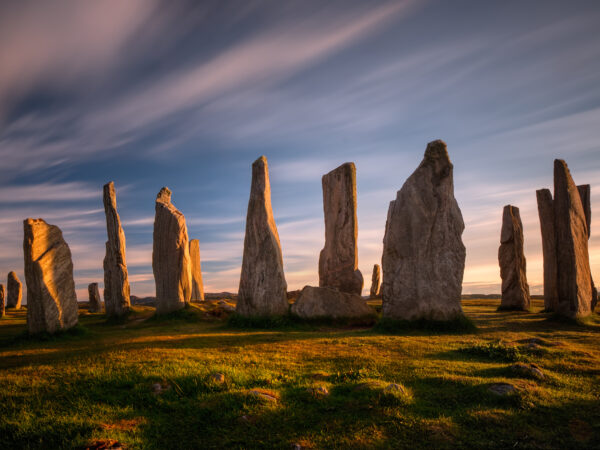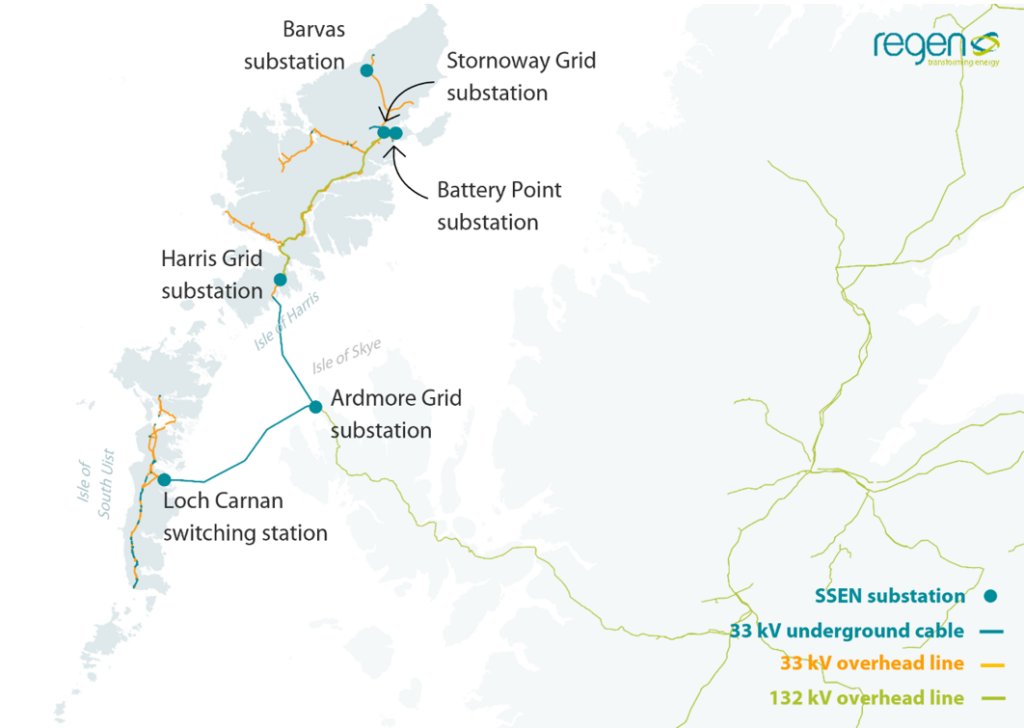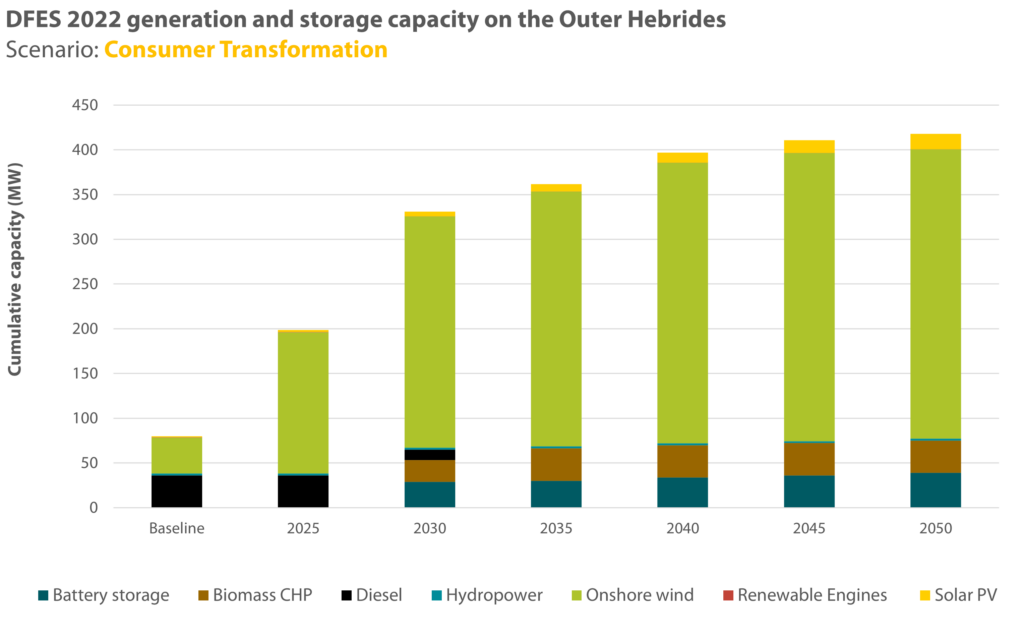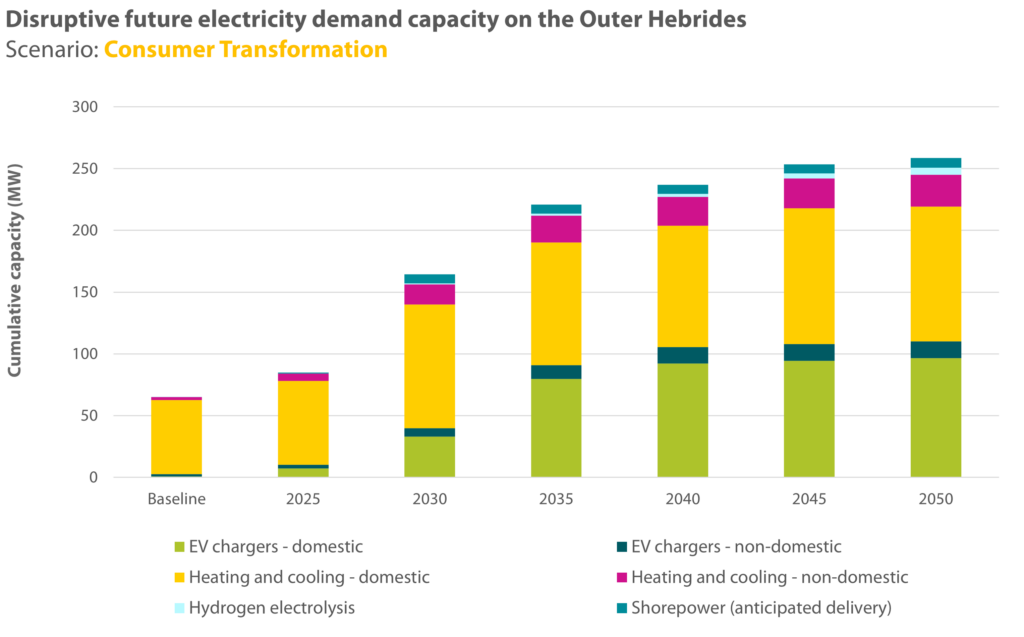Regen has been working with Scottish and Southern Electricity Networks (SSEN) to collate evidence on the future electricity load growth of several Scottish island groups. The evidence case report for the Outer Hebrides is the first of three studies that will help SSEN better understand the investment needed to enable a net zero transition for Scottish island communities.

SSEN is currently engaging with Ofgem around potential additional funding to support investment in network cables supplying the Outer Hebrides, Inner Hebrides and Orkney. This is being explored through SSEN’s Hebrides and Orkney Whole System Uncertainty Mechanism (HOWSUM) programme of work, which is being assessed across 2024 and 2025.
Building on the delivery of SSEN’s Distribution Future Energy Scenarios (DFES) and a similar load growth evidence case report completed for the Isle of Wight, Regen was tasked to develop a body of evidence around the future load electricity growth and decarbonisation aspirations to support SSEN’s evidence submission to Ofgem.
Regen has used projections from SSEN’s DFES 2022 analysis, alongside information on pipeline projects currently in development and engagement with key island stakeholders, to develop a forward-looking view of how electricity generation and demand may evolve on the Outer Hebrides. This work included research and engagement with active industries on the islands that are currently outside of the core DFES scope, such as maritime vessels, aviation, aquaculture and whisky distillery decarbonisation.
The Outer Hebrides
As an interconnected island chain off the north-west coast of Scotland, the Outer Hebrides consists of moorland, mountains, white-sand beaches and small port towns. Also, like many other Scottish Islands, there is also a distilling industry present – the Hebridean Whisky Trail being a popular tourist attraction.
In terms of renewable electricity generation, the Outer Hebrides also has some of the strongest wind resources in the UK, which has led to several onshore wind projects coming online over the past 10-15 years.
To support both existing electricity demand and electricity generation on the Outer Hebrides, the islands’ energy system is fed by subsea cables coming across from the west coast of the Scottish mainland. A distribution network then feeds power to the islands and residential areas of Lewis and Harris, and the main town of Stornoway in the north, down to the islands of North and South Uist, Benbecla and Barra in the south.

Figure 1
Existing network infrastructure in the Outer Hebrides
Source: SSEN distribution network mapping data
Future plans
As with the rest of the UK, the future decarbonisation pathways and electricity requirements of the islands are rapidly evolving. Comhairle nan Eilean Siar (the islands’ local authority) has produced a Climate Change Strategy covering 2022-2027 which includes several commitments around energy and net zero. Many of these commitments will likely drive increased demand on the island’s electricity network, including increased renewable energy deployment, green hydrogen production, the installation of low carbon heating and an increased adoption of low carbon transport.
Progress towards these decarbonisation aims could potentially be restricted by constraints on the local electricity network. Unlocking the future uptake of renewable generation and low carbon technologies across the islands could require significant network upgrades and reinforcement, an opportunity that was identified by SSEN within their RIIO-ED2 business plan. Regen’s work to understand the potential scale of load growth and local ambition, will contribute to a more detailed assessment of the options and solutions for a future network design for the islands.
Future load growth – findings
Regen’s analysis and engagement suggests that, under some scenarios, much more generation capacity could be developed across the Outer Hebrides by 2050, including:
- Up to 378 MW of renewable generation capacity.
- Up to 40 MW of battery storage capacity.

Figure 2
Cumulative distributed electricity generation and storage capacity on the Outer Hebrides
Source: SSEN DFES 2022 projections
The electrification of transport, heat and other commercial decarbonisation activities will also drive an increase in electricity demand across the Outer Hebrides by 2050. This includes:
- Up to 109 MW of potential EV charging capacity, serving over 12,000 EV cars, light goods vehicles and the island’s bus fleet.
- Up to 112 MW of heat pumps/electrified heating operating in homes and businesses.
- Around 8 MW (or more) of shore power capacity to service the island’s ferry routes.
- Wider island business decarbonisation strategies that will further increase electricity demand, including the potential electrification of island distilleries and aquaculture processes.

Figure 3
Cumulative distributed electricity demand capacity on the Outer Hebrides
Source: SSEN DFES 2022 projections
Note this does not include all sources of domestic or commercial and industrial demand.
From our analysis and engagement, it’s clear that future electricity load growth could be significant on the island. There is significant market, community interest and unexploited resource that is driving interest in the future development of distributed electricity generation. A variety of industries across the Outer Hebrides are also in the process of shifting towards a net zero future. However, these are, in part, limited by the challenges and constraints of the current network infrastructure.
The evidence case report for the Outer Hebrides is the first of three reports that Regen is developing to help SSEN better understand the investment needs case for the electricity networks supplying some of the Scottish Islands. Similar assessments for the Orkney Islands and Inner Hebrides are currently being developed.
Regen will continue to work with SSEN as they explore and progress the next steps for the investment case and future network design for these islands.
For the wider HOWSUM submissions being developed for the other island groups (Orkney and Inner Hebrides), SSEN and Regen will be hosting webinars at the end of February, which will provide an update on the process and insights gathered to date. You can register for these free online events below:
Orkney HOWSUM webinar (29th Feb 10am – 11am): https://ssen.engage-360.co.uk/events/3897
Inner Hebrides HOWSUM webinar (29th Feb 2pm – 3pm): https://ssen.engage-360.co.uk/events/3896
For more information on this project and our wider work on the future of our electricity networks, please contact the Regen team and visit the project page:
Becky Fowell, Energy Market Analyst – rfowell@regen.co.uk
Ray Arrell, Associate Director – rarrell@regen.co.uk
